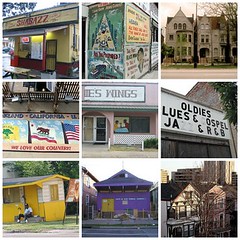The Rolling Jelly Series (4): Sartorial Matters
[ Here is Part 4 of the Rolling Jelly Series.]
In an earlier post I touched on some of the sartorial matters relating to "St. James Infirmary." And at various points in his conversations with Alan Lomax, Jelly Roll Morton had a thing or two to say on the subject of style. It's clear Morton had a sense of style himself: Lomax describes him showing up for their 1938 interview sessions in gold rings, a sharp suit, and a diamond "set in gold in his front incisor."
In his young New Orleans days, Morton professes, he always wore "a Stetson hat and a pair of Edwin Clapp shoes." That earlier post was basically about Stetsons. Interestingly, Edwin Clapp shoes are mentioned in some versions of "SJI," but I've learned very little about the company, or brand. (If you know something, speak up!)
Morton also goes into an excellent breakdown of tough-guy -- gangsta? -- style. "All those boys in New Orleans dressed very well," he observes, although he seems not to be particularly impressed by certain trends. He says, for example, the red flannel undershirt was a real status marker in this crowd, and certain ladies were impressed by it -- but Morton seems to find it silly, and to find the women who were impressed by it to be not worth bothering with. Also:
They all had the real tight trousers, those days. When they'd get into their trousers, they'd fit 'em like a sausage. ... I'm telling you, it was very, very seldom that you could really button the top of a person's trousers. .. And they had suspenders and -- of course, they didn't really need any suspenders because they was so tight fitting. And it was one of the fads that they would take on suspender down, as they would walk along with a walk that they had adopted from the river, which they called "shooting the agate."Lomax tries to get a little more detail on what that means. Morton does his best: "It was a kind of a very mosey walk, with holding two fingers down, one finger on each hand ... the index finger ... With the arms stiffed out, you know, especially when they would be standing."
While Morton went for the Edwin Clapp shoes, some of these "tough babies" preferred "what they call St. Louis flats and the Chicago flats."
These shoes were made with the cork soles on 'em and no heels and would turn up in the front. A lot of times they would have different designs in the toes of the shoes, such as gamblers' designs, such maybe a club, or a diamond, a heart, or a spade. I have heard later on that even some of 'em had made arrangements to have some kind of electric light bulbs in the shoes with a battery in their pocket, and when they would get around some Jane or something that was kind of simple, and they could make her -- as they call making 'em -- why they'd press a button in their pocket and light up the little bitty bulb in the toe of their shoes.
Lomax seems to have a little trouble believing this. In fact, he revisited the subject in 1949, with some of the musicians he interviewed later, who were contemporaries of Morton's. In a conversation with Albert Glenny and Leonard Bechet, he brought up "sporting life" style. Neither man really seemed interested in the subject, but it's clear even from there dismissive comments -- about silk shirts or the "funny shoes" that "turned up" that some of the tastelessly flashy men wore -- that Morton wasn't all wrong.
Later, when Lomax asked whether Buddy Bolden ever wore his shirt open with a red undershirt showing, Glenny denied it. "Oh no," he said. "Well, I ain't gonna say that, because I knew him better. ... I used to drink with him and play with him, and have a good time with him, myself." Then he laughed.
<-- Part 3. Part 5 -->



0 Comments:
Post a Comment
<< Home